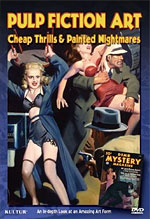Lurid covers come to life on the highly saturated TV screen, thanks to the recently released DVD documentary, Pulp Fiction Art: Cheap Thrills & Painted Nightmares (Kultur International Films).

The paintings are the primary subject though Pulp Fiction Art also traces the history of the pulp magazines from newspaper serials to penny dreadfuls to Argosy and through the pulp boom and the economic bust of the Depression and on through the decline and demise of the pulps. Old footage and narrator-read accounts tell the story.
If you’ve read the book Pulp Art or are familiar with the pulp paintings from the Robert Lesser collection, you’ll recognize most of the works shown in the 57-minute film. There are no surprises in that regard. But the careful editing and montages make the paintings jump to life.
Taking the lead from documentarist Ken Burns, the pulp paintings zoom in and out, and pan around to emphasize key portions of the works.
For example, early in the film, Lesser describes the rationale for creating these wild pulp covers: The allure they had with readers, particularly boys.
“Here is this beautiful, young girl, blonde, in dire trouble,” Lesser says. “She’s being attacked by this terrible guy. And you’re going to save her, and she, of course, is going to be very, very grateful to you and show you in as many ways as a woman can.”
As he says this, the screen starts with a shot of the hero, pans and zooms in tight on the girl in distress, then pulls out to reveal the whole scene with the villain holding a blowtorch. The painting, by Norman Saunders, originally ran as the cover of a 1938 issue of Ten Story Detective.
In addition to Lesser, pulp historian Robert Weinberg, Hard Case Crime publisher Charles Ardai, pulp-artist-turned-portraitist Everett Raymond Kintsler and other modern-day commentators look back at the pulps throughout the film.
But the real treats for the serious pulp fan are the interviews with pulpsters Saunders, Rafael DeSoto and Ernest Chiriacka. They provide a first-hand look at life during the pulp age.
To illustrate what Lesser describes as “a Holocaust of American culture” – the destruction of most of the original pulp cover paintings – DeSoto recalls not even wanting his paintings back. “No, I didn’t, and I must say that I was very foolish enough not to even sign them because I had an idea when I was young that I would be a gallery artist, a fine artist.”
Sadly, those paintings had but one use at the time: to sell magazines. Once their job was done, they weren’t of much value to pulp publishers, or many of the artists, any longer. Most were destroyed, tossed out with the trash or painted over.
If you enjoy looking at the covers of pulps as much as reading them, then Pulp Fiction Art is a worthy addition to your pulp reference library. It’s available directly from Kultur Films, as well as through other sources. (Click the image above to see a brief preview of the film.)
– William


A distinctly fun video documentary. I regret the lack of availability of further interview with more artists, and perhaps interviews with the family of others (I met a grandson of H.J. Ward a few years ago and he was very surprised that I had even heard of him, much less had reprints of some of Ward’s work). Otherwise, lots of fun!